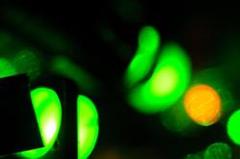URL: https://www.desy.de/news/news_search/index_eng.html
Breadcrumb Navigation
DESY News: World's best metronome enables slow-motion pictures of atoms and molecules
News
News from the DESY research centre
World's best metronome enables slow-motion pictures of atoms and molecules

The accuracy of the laser beat is ten attoseconds (quintillionth of a second), or 0.000 000 000 000 000 01 seconds. Atomic clocks achieve a higher precision, yet on longer time scales. Only with this accurate laser beat it is possible to take motion pictures of the nanocosm, as the movement of electrons in molecules and atoms take place on time scales of some 100 attoseconds to femtoseconds. "That is about the time an electron needs for orbiting a hydrogen nucleus or for the electric charge to move through a molecule during photosynthesis," Kärtner explains. With novel light sources, so-called free-electron lasers, researchers expect fundamental new insights into those processes.
Free-electron lasers like FLASH at DESY or the future European XFEL X-ray laser, currently being built at Hamburg, produce extremely short and intense flashes of ultraviolet or X-ray radiation. With this short wavelength light pulses, it is possible to take flash photos of single molecules and atoms. However, the intense energy of each light pulse destroys the sample.
Therefore, the slow-motion movie production of a molecular process requires the repetition of the same process with a fresh sample and each picture is taken a bit later. But how is it possible to reliably postpone the exposures by the same interval from shot to shot? This is achieved with optical lasers used as clock generators. Within these lasers a light pulse oscillates between two mirrors, with part of the pulse being partially transmitted through one of the mirrors.
This process generates a pulse train that is used to synchronize all components of a free-electron laser, including the start of a process and the subsequent exposure to a X-ray flash.
Because the optical laser pulse is oscillating so steadily within the clock generator, it is often called an optical flywheel. In mechanics, flywheels are used among other things to stabilize periodical movements. However, up to now it was unclear, how accurate these optical flywheels are running. This could only be measured directly with an even more precise instrument, which simply doesn't exist.
Therefore Kärtner's team compared two highly accurate laser clock generators at MIT. This way the average error of both devices could be measured. Assuming they are equally precise, both are keeping the stroke at a precision of 10 attoseconds for at least a thousand laser pulses. This enables a synchronization that is about a thousand times more accurate than the current standard at free-electron lasers.
The team reports that the extreme precision is stable on the time scale of microseconds. Longer stability can be achieved by synchronizing the laser with atomic processes like the excitation and following relaxation of an atom. This is how modern atomic clocks work.
Scientific paper
“Optical flywheels with attosecond jitter”; Andrew J. Benedick, James G. Fujimoto and Franz X. Kärtner, “Nature Photonics” (2012); DOI:10.1038/nphoton.2011.326
Images







